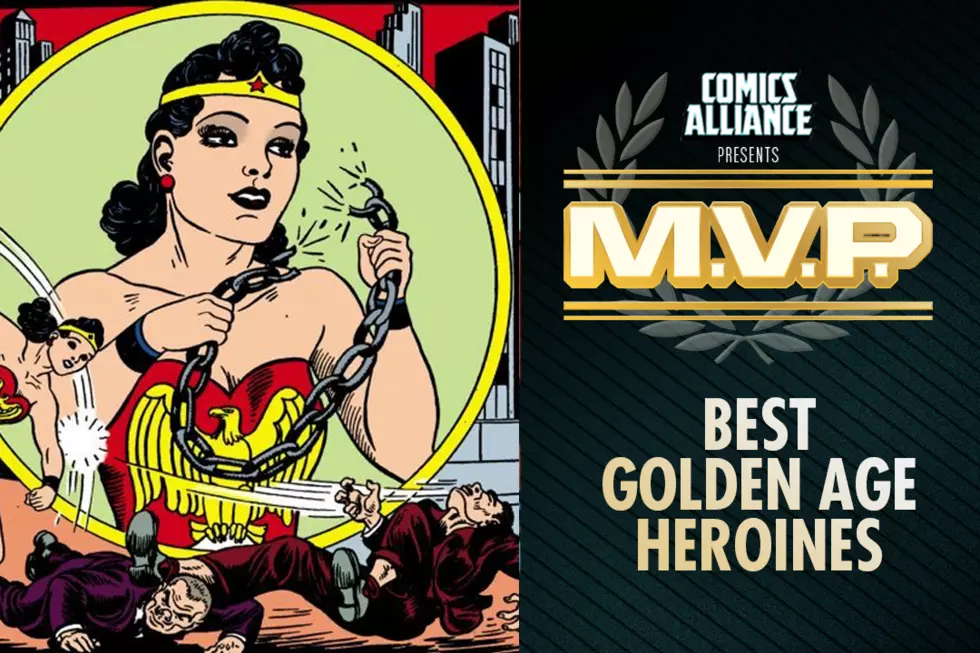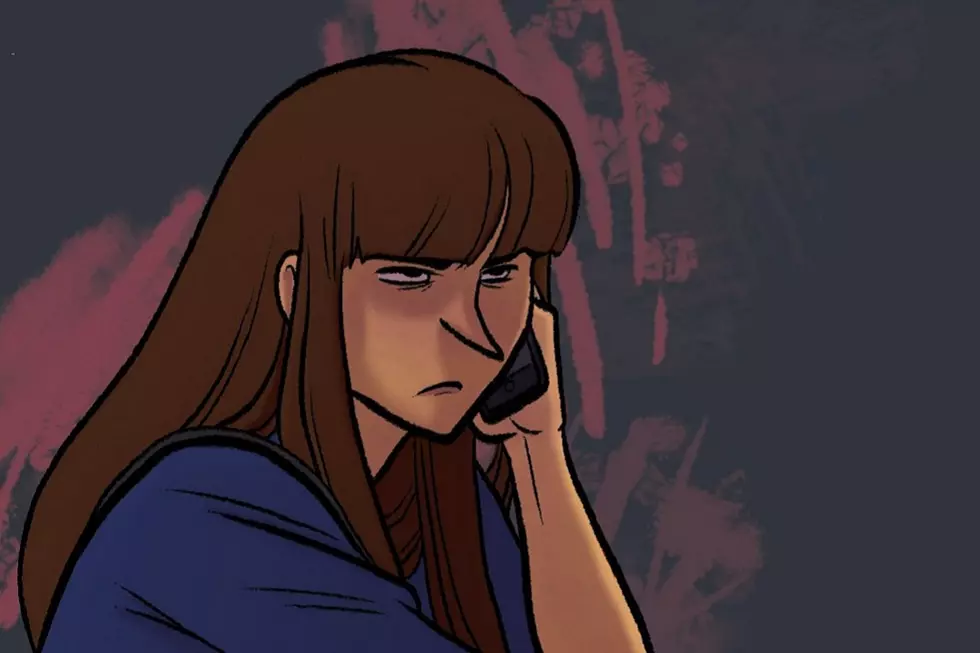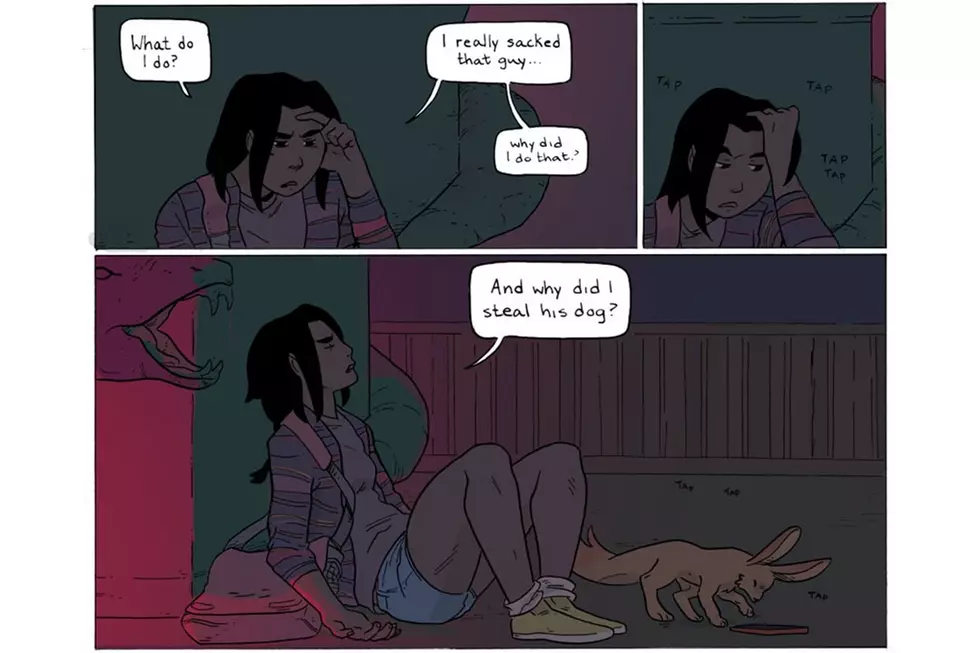
Hire This Woman: Cartoonist Sally Jane Thompson
In the overwhelmingly male comic book industry, it has been a challenge for some editors and readers to see the ever growing number of talented women currently trying to make a name for themselves. With that in mind, ComicsAlliance offers Hire This Woman, a recurring feature designed for comics readers as well as editors and other professionals, where we shine the spotlight on a female comics pro on the ascendance. Some of these women will be at the very beginning of their careers, while others will be more experienced but not yet “household names.”
Cartoonist Sally Jane Thompson has created many comics on her own such as the webcomic From! and the graphic novel Atomic Sheep. She has also contributed art to projects like Womanthology: Space and Liberator Volume 1.
ComicsAlliance: What's your preferred form of creative output?
Sally Jane Thompson: My own writer-artist projects are my favorite -- unsurprisingly, since those are the most personal, the projects that have the most of me in them. But they're complemented by the creative challenge of working on others' stories, and for those I prefer doing either full-service monochrome art, or pencils and inks if it's a team and/or color book.
CA: Do you work on paper or digitally? Why?
SJT: I do most of the work on paper, up to inks, and then clean up, color (if needed), and letter digitally. I've recently been experimenting with ink wash to move even more of the process to paper; I like the tactile feedback I get from a brush, and the way it forces me to accept and work with small quirks that add character.
CA: What’s your background/training?
SJT: I did fine art in university and started doing comics in my free time during the degree. I think the first proper comic I did was in a lit class on Canadian long-form poetry, where my excellent prof let me do part of my final essay as a comic. Which is fitting, as for me comics have a strong relation to poetry, and I discovered while doing that essay how amazing a vehicle they are for communicating a sense of place and time. Following that, I did an MA in art and design and started freelancing and self-publishing while doing that.
CA: How would you describe your creative style?
SJT: Every story is different, so I try and adjust a bit stylistically for each one, but I think there's a recognisable thread of me-ness running through all of it! Common elements are organic curves and expressive inking, and a focus on character and expressions, with manga-influenced layouts and sense of place. Writing-wise, I tend towards contemplative slice-of-life, often with a magic realist twist. A friend once described my style as "bold lines with an air of feminine certainty," which I hope she won't mind me quoting, as I loved that!
CA: What projects have you worked on in the past? What are you currently working on?
SJT: Recent projects include Atomic Sheep, a coming-of-age graphic novel released last year by AAM Markosia; a short comic called Now and Then; and artwork on stories for Womanthology: Space (IDW, with writer Jody Houser and colorist Katherine Layno) and Liberator Vol 1 (Black Mask Studios, with writer Alex de Campi and colorist Jenn Manley Lee). At the moment I'm working on a new graphic novel, and I'm collaborating with Jody Houser on a fairy-tale influenced one-shot. I've recently started an illustration side-project called Blood and Roses, and I'll be doing art duties on a great children's comic soon, which I'm incredibly excited about!
CA: Approximately how long does it take you to create a 20-page issue?
SJT: It varies based on the style and what roles I'm filling. So I might write, pencil, ink and letter a 20-page short in a month because on my own work the style tends to be more pared down, thus quicker to create (at least, I might if I had a month where I could work on my own work full-time!). But pencils and inks on something more detailed and, for lack of a better term, more mainstream, would also take around a month (full time).
Of course, few projects are that linear (sit down and draw one thing for a month) in their production, feedback times, etc. -- but it's a useful starting point for working out a schedule that works for everyone!
CA: What is your dream project?
SJT: I've only got so long on this planet, and want to offer something that makes the world even a tiny little bit better for me being here, so a dream project would have some positive effect -- whether being a help and encouragement to people, or even just increasing empathy, as good fiction so often does. Aside from that, a dream project (whether writing, drawing, or both!) would mix the fantastical and the mundane, be full of atmosphere and beautiful imagery, have wonderful female characters (and be focussed on their inner journies/development), and allow for spacious layouts and quiet moments. Possibly aimed at teens. Interesting, personal, and just plain good storytelling. And, since we're dreaming, it would be read by tons of people, of course!
CA: Who are some comic creators that inspire you?
SJT: I hugely admire Hope Larson for her sensitive, gentle storytelling and organic inking; Becky Cloonan for her evocative lines; Jillian Tamaki for the atmosphere and inventiveness in her work; Kaoru Mori for the richness of her focus on small real-life details, Ashinano Hitoshi for the quiet expansiveness of his stories, and so so many others!
CA: What are some comics that have inspired you either growing up or as an adult?
SJT: I grew up with Tintin, Asterix and Archie comics. When I got truly sucked into comics it was via manga as a teen. Ai Yazawa's Paradise Kiss, Ashinano Hitoshi's Yokohama Shopping Trip, Iou Kuroda's Sexy Voice and Robo and Kozue Amano's Aria all had a big influence on me. I started reading more widely in university, the time when I started making comics as well, and comics like the Flight anthologies, Hope Larson's Salamander Dream, and Craig Thompson's Blankets were a huge influence. Of course, I continue to find comics that knock me for six and affect how I think about my work – most recently Fanny Britt and Isabelle Arsenault's Jane, the Fox and Me.
CA: What’s your ideal professional environment?
SJT: I currently work at home, but I do get a bit cabin-fever-y and have to take my work to coffee shops sometimes. I very much hope at some point I'll be able to work in a shared studio with a few other comickers and illustrators, where seeing eachother working everyday would give us a mutual boost. Ideally, it would have a messy space for painting, and a few spare work spots -- couch, tables -- as I find myself roaming over the course of a day!
CA: What do you most want our readers and industry professionals to know about your work?
SJT: The stories I want to work on stay with the reader, and have depth and character -- but good stories come in all shapes and sizes and genres, and I'm always up for a challenge, even if it looks a little different than what I've done before!
Other than that, I place high importance on being professional and pleasant, and try to push myself on every new project. I'm a little biased, but I think I'm nice to work with!
CA: How can editors and readers keep up with your work and find your contact information?
SJT: You can contact me via my site or at sally (at) sallyjanethompson.co.uk. You can keep up with my work on my blog, and I'm on twitter rather too much at @sallythompson.
If there is a woman you’d like to recommend or if you’d like to be included in a future installment of this feature, drop us a line at comicsalliance-at-gmail-dot-com with "Hire This Woman" in the subject line.
More From ComicsAlliance
![When Everything Is Pink, Nothing Is Pink: Sarah Stern On Color And Creativity [Interview]](http://townsquare.media/site/622/files/2017/03/Cindersong-feat.jpg?w=980&q=75)








